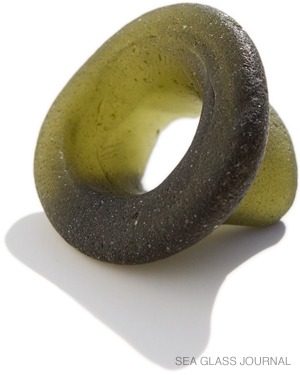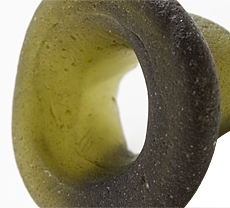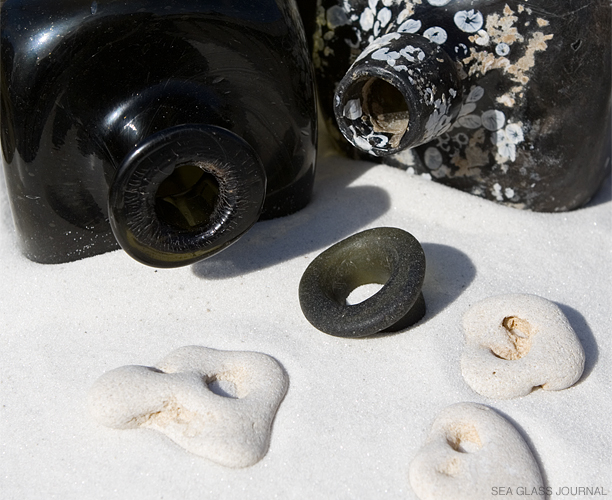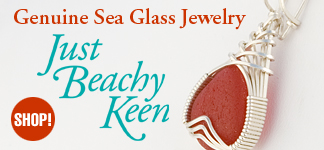The Sea Glass Shard of the Month: January 2015
A Sea Glass Bottle Top From A Very Old Case Gin

Sea Glass Specifications:
Color: Dark Olive Green
Ave Diameter: 34 mm (1.34")
Weight: 16.1 grams (0.568 ounces)
Age: 150 to 225 Years
This month's featured sea glass specimen is the remnant of the top of an old case gin bottle. Case gins, also known as taper gins, are some of the earliest forms of liquor bottles, dating from at least the mid 17th century up through the early 20th century. The square cross section design of a case gin allowed for the efficient packing and transportation of these bottles in wooden cases, each containing from 4 to 24 bottles.

An example of a case gin finished with the same style lip as the sea glass featured.

Close inspection of this sea glass bottle top shows a faint line where a string of molten glass was added and rolled to finish the lip.
While the earliest case gins were straight sided from top to bottom, a taper from the shoulder down to the base developed in later designs. This tapared bottle design did not vary much over time but the top design continued to evolve. This can assist in dating the age of the bottle, and in this case, the approximate age of the sea glass bottle top.
"...this month's sea glass shard is at least 150 years old and possibly older than 200 years."
Upon close inspection of the inside of the sea glass lip a faint, varying line of separation is evident. This indicates that a string of hot glass was added by the glass blower to the top of the bottle after the blow pipe was sheared off. The molten glass was then flared out, rolled over and finished by flattening the top with a wooden paddle. This technique was in common use from the late 1700s until the mid 1800s and indicates that this month's sea glass shard is at least 150 years old and possibly older than 200 years.
Most case gins were a dark olive green color like this month's sea glass shard. This is one of the oldest glass colors and was commonly used to protect the contents from ambient light. Other rarer colors used for case gins were dark amber, cobalt blue and even clear.
This sea glass bottle top was found on a private waterfront location where an onion farm operated in 19th century Rhode Island. It was probably tossed into the ocean by a farmhand where, over the ages, it was shaped into a well-worn and conditioned gem to eventually be found by a fortunate sea glass collector.

Keep up-to-date on all things sea glass... "Like Us" on Facebook!
Sea Glass Journal on Facebook






